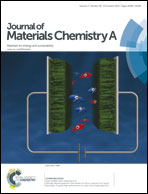Synthesis of porous peanut-like LiNi0.5Mn1.5O4 cathode materials through an ethylene glycol-assisted hydrothermal method using urea as a precipitant
Abstract
The high voltage spinel LiNi0.5Mn1.5O4 with a peanut-like morphology and porous structure was synthesized by an ethylene glycol-assisted hydrothermal method using urea as a precipitant followed by high-temperature calcination. For comparison, the LiNi0.5Mn1.5O4 sample was also synthesized in the aqueous solution in the absence of ethylene glycol (EG). The as-prepared materials were characterized by XRD, SEM, TEM, FT-IR, CV, EIS and galvanostatic charge/discharge tests. The presence of EG in the hydrothermal process improves the dispersity and decreases the particle size of the final LiNi0.5Mn1.5O4 product, thus leading to its better rate capability, whose discharge capacity at a 10C rate could reach as high as 121.4 mA h g−1. On the other hand, the presence of EG in the hydrothermal process could make the reagents mix more homogeneously, thus leading to higher crystallinity, lower impurity and Mn3+ contents, which are advantageous to the cycling performance. Furthermore, the porous structure of the LiNi0.5Mn1.5O4 material could effectively mitigate the volume change caused by the repeated Li+ insertion/extraction process, which is also conducive to the cycling stability. The LiNi0.5Mn1.5O4 cathode material synthesized by the EG-assisted hydrothermal process shows a capacity retention rate of 96.4% after 100 cycles at a 1C rate. Additionally, a possible formation mechanism for the Ni0.25Mn0.75CO3 precursor with a peanut-like morphology was also proposed.


 Please wait while we load your content...
Please wait while we load your content...